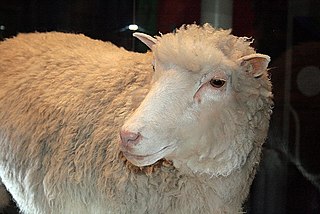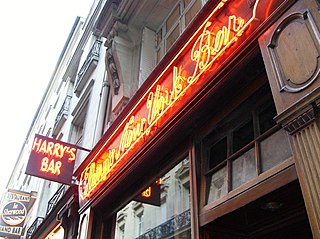
A cocktail is an alcoholic mixed drink, which is either a combination of spirits, or one or more spirits mixed with other ingredients such as fruit juice, flavored syrup, or cream. There are various types of cocktails, based on the number and kind of ingredients added. The origins of the word cocktail have been debated. The first known written mention of cocktail as an alcoholic beverage appeared in The Balance and Columbian Repository May 13, 1806. The early to mid-2000s saw the rise of cocktail culture through the style of mixology which mixes traditional cocktails and other novel ingredients.

Dolly was a female domestic sheep, and the first mammal cloned from an adult somatic cell, using the process of nuclear transfer.

Secondary sex characteristics are features that appear during puberty in humans, and at sexual maturity in other animals. These characteristics are particularly evident in the sexually dimorphic phenotypic traits that distinguish the sexes of a species, but--unlike the sex organs --are not directly part of the reproductive system. Secondary sex characteristics are believed to be the product of sexual selection for traits which display fitness, giving an organism an advantage over its rivals in courtship and in aggressive interactions.

French 75 is a cocktail made from gin, Champagne, lemon juice, and sugar. It is also called a 75 Cocktail, or in French simply a Soixante Quinze.

The sidecar is a cocktail traditionally made with cognac, orange liqueur, plus lemon juice. In its ingredients, the drink is perhaps most closely related to the older Brandy Crusta, which differs both in presentation and in proportions of its components.

The martini is a cocktail made with gin and vermouth, and garnished with an olive or a lemon twist. Over the years, the martini has become one of the best-known mixed alcoholic beverages.

Serge Abrahamovitch Voronoff was a French surgeon of Russian extraction who gained fame for his technique of grafting monkey testicle tissue on to the testicles of men for purportedly therapeutic purposes while working in France in the 1920s and 1930s. The technique brought him a great deal of money, although he was already independently wealthy. As his work fell out of favour, he went from being highly respected to a subject of ridicule. Other doctors, and the public at large, quickly distanced themselves from Voronoff, pretending they had never had any interest in the grafting techniques. By the time of his death in 1951 at the age of 85, few newspapers noted his passing, and those that did acted as if Voronoff had always been ridiculed for his beliefs.

Harry Frederick Harlow was an American psychologist best known for his maternal-separation, dependency needs, and social isolation experiments on rhesus monkeys, which manifested the importance of caregiving and companionship to social and cognitive development. He conducted most of his research at the University of Wisconsin–Madison, where humanistic psychologist Abraham Maslow worked with him for a short period of time.
Brass Monkey is a name given to a number of different cocktail recipes. As with many lesser-known cocktails that are named after colloquial expressions, widely differing recipes share the same name.

Harry's New York Bar is a bar in Paris, France located at 5, Rue Daunou, between the Avenue de l'Opéra and the Rue de la Paix. The bar was acquired by former American star jockey Tod Sloan in 1911, who converted it from a bistro and renamed it the "New York Bar." Sloan had gone partners with a New Yorker named Clancy who owned a bar in Manhattan. That bar was dismantled and shipped to Paris. Sloan then hired Harry MacElhone, a barman from Dundee, Scotland, to run the place.

The Pit of despair was a name used by American comparative psychologist Harry Harlow for a device he designed, technically called a vertical chamber apparatus, that he used in experiments on rhesus macaque monkeys at the University of Wisconsin–Madison in the 1970s. The aim of the research was to produce an animal model of depression. Researcher Stephen Suomi described the device as "little more than a stainless-steel trough with sides that sloped to a rounded bottom":
A 3⁄8 in. wire mesh floor 1 in. above the bottom of the chamber allowed waste material to drop through the drain and out of holes drilled in the stainless-steel. The chamber was equipped with a food box and a water-bottle holder, and was covered with a pyramid top [removed in the accompanying photograph], designed to discourage incarcerated subjects from hanging from the upper part of the chamber.
Monkey gland sauce is a restaurant item in South Africa. The tangy sauce is prepared in several manners, and may include a blend of fruit and spices. It is typically served with meats, such as steak, hamburgers, pork ribs or chicken. Several popular South African fast food chains serve a monkey gland burger.

Cocktail garnishes are decorative ornaments that add character or style to a mixed drink, most notably to cocktails.

The Paradise is an IBA official cocktail, and is classified as a "pre-dinner" drink, an apéritif.

A Bloody Mary is a cocktail containing vodka, tomato juice, and other spices and flavorings including Worcestershire sauce, hot sauces, garlic, herbs, horseradish, celery, olives, salt, black pepper, lemon juice, lime juice and celery salt. Some versions of the drink, such as the "surf 'n turf" Bloody Mary, include shrimp and bacon as garnishes. In the United States, it is usually consumed in the morning or early afternoon, and is popular as a hangover cure.
Harry MacElhone was an early 20th century bartender, most famous for his role at Harry's New York Bar in Paris, which he bought in 1923.
Monkey gland may refer to surgeon Serge Voronoff's technique of grafting monkey testicle tissue on to the testicles of men for purportedly therapeutic purposes. It may also refer to:













